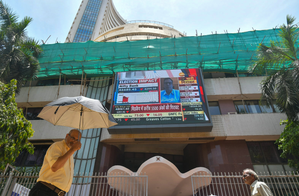Sensex may hit 1 lakh mark by July 2026 in bull case scenario: Report
By IANS | Updated: August 4, 2025 20:24 IST2025-08-04T20:15:07+5:302025-08-04T20:24:47+5:30
Mumbai, Aug 4 The Sensex could scale the historic 1 lakh mark by July 2026 under a bullish ...

Sensex may hit 1 lakh mark by July 2026 in bull case scenario: Report
Mumbai, Aug 4 The Sensex could scale the historic 1 lakh mark by July 2026 under a bullish scenario, a report said on Monday.
In the bull case, which has a 30 per cent chance, the Sensex could rise to 1,00,000 due to the following factors: the RBI lowering policy rates, the reversal of global trade tariffs, persistently low oil prices (below $65/barrel), and a positive surprise in government reforms, international brokerage firm Morgan Stanley said in its report.
According to the brokerage firm, a final trade agreement with the United States, additional capital expenditure announcements, accelerated loan growth, consistent improvement in high-frequency data, and improved trade with China can be catalysts for the potential massive growth.
Robust population growth, a functioning democracy, policies influenced by macro stability, and improved infrastructure will also be among crucial factors driving the index growth, the report said.
According to the brokerage firm, the Sensex will reach an all-time high of 89,000 by July 2026, even in the base-case scenario. The company bases its prediction on a "base case scenario" that has a 50 per cent probability of happening.
Strong domestic investment, macroeconomic stability, sustained fiscal consolidation, moderate US growth (free of recession), and stable oil prices are all predicated on this result. It also takes into account a favourable trade agreement between the US and India.
However, in a bear case scenario, which has a 20 per cent chance, the Sensex will drop to 70,000 by July 2026, the brokerage firm stated.
A major global economic slowdown, a US recession, aggressive monetary tightening by the RBI, and an increase in oil prices above $100/barrel are among the risks, the report highlighted.
In the face of deteriorating macro fundamentals, this scenario would also show slower earnings growth and a de-rating of valuations, the report stated.
Disclaimer: This post has been auto-published from an agency feed without any modifications to the text and has not been reviewed by an editor
Open in app